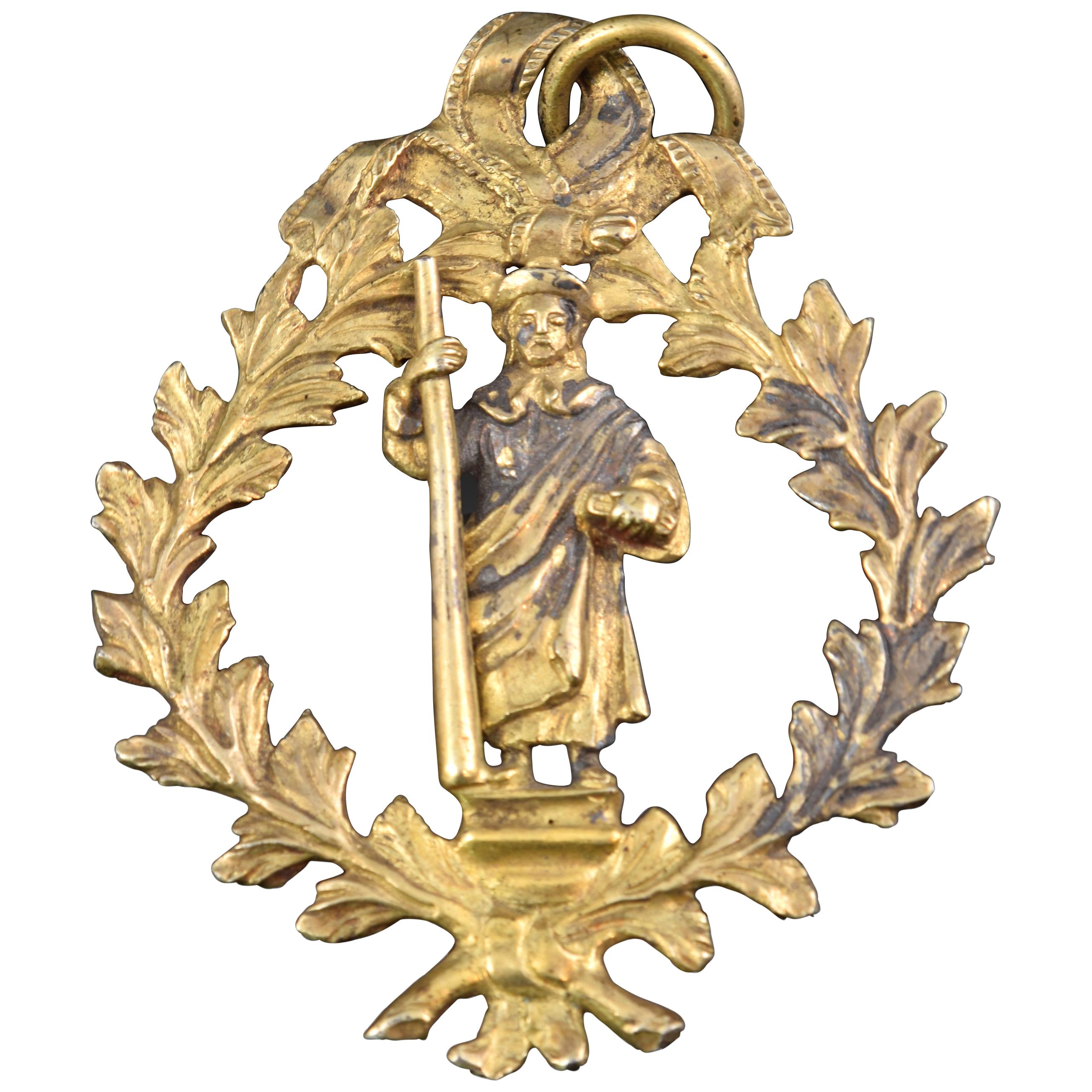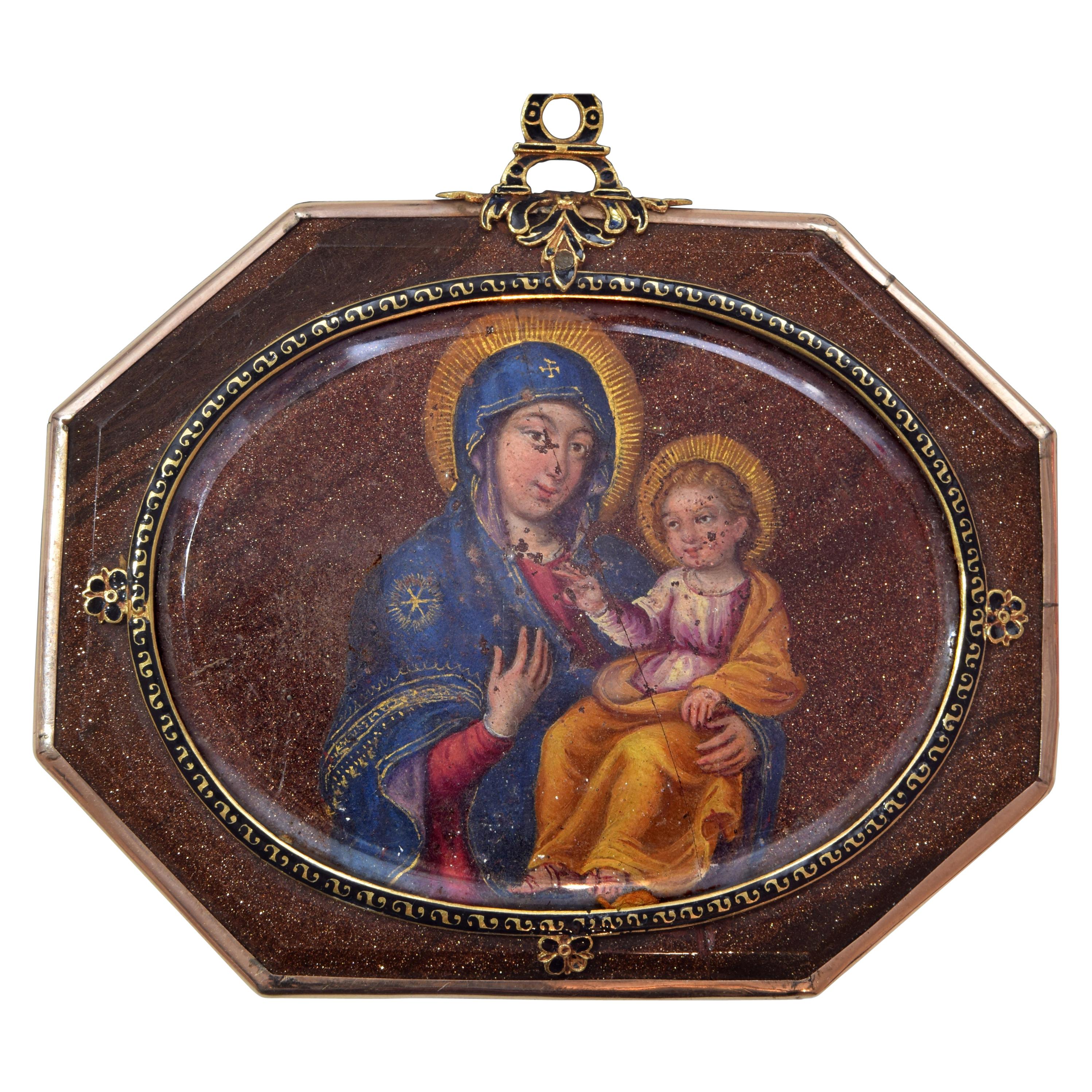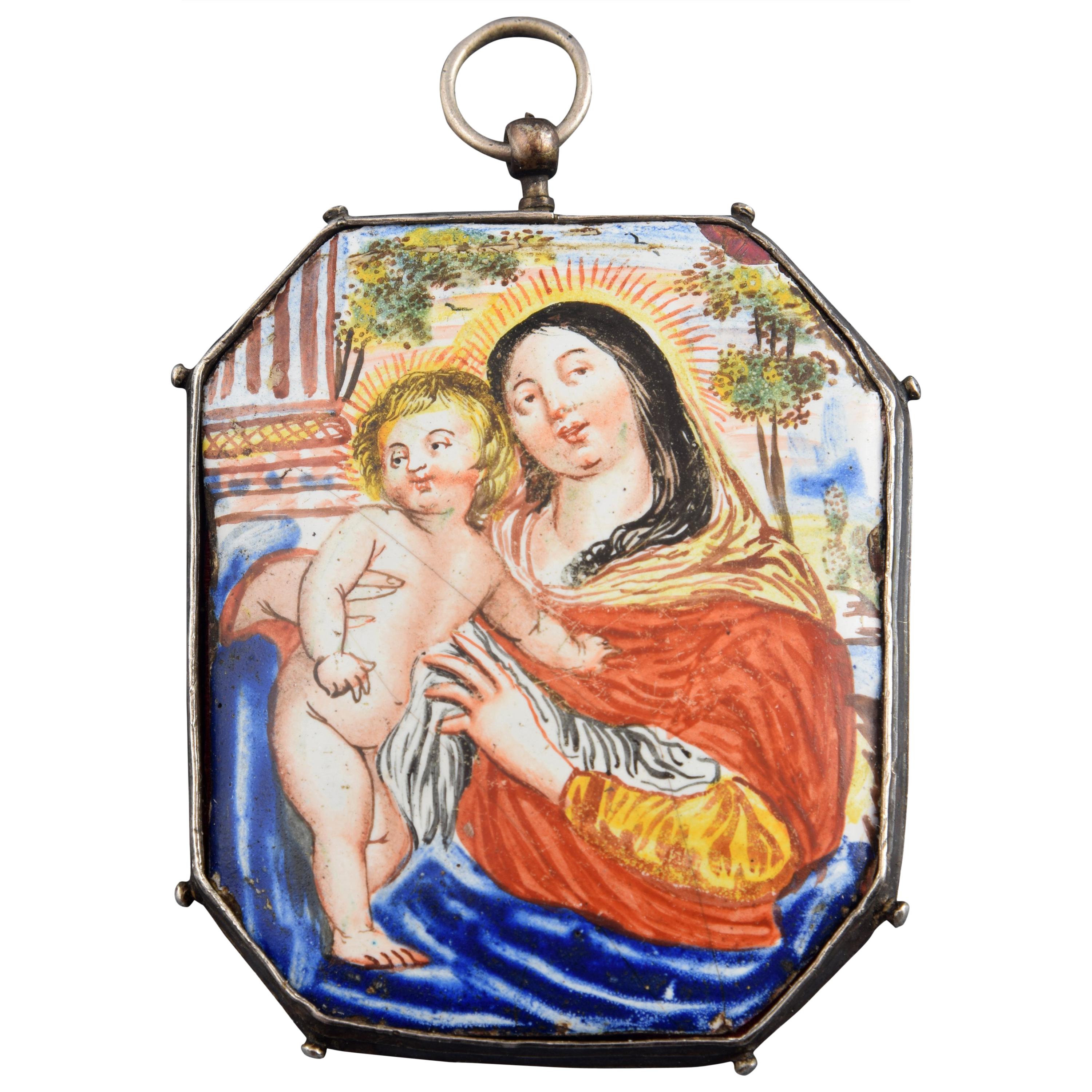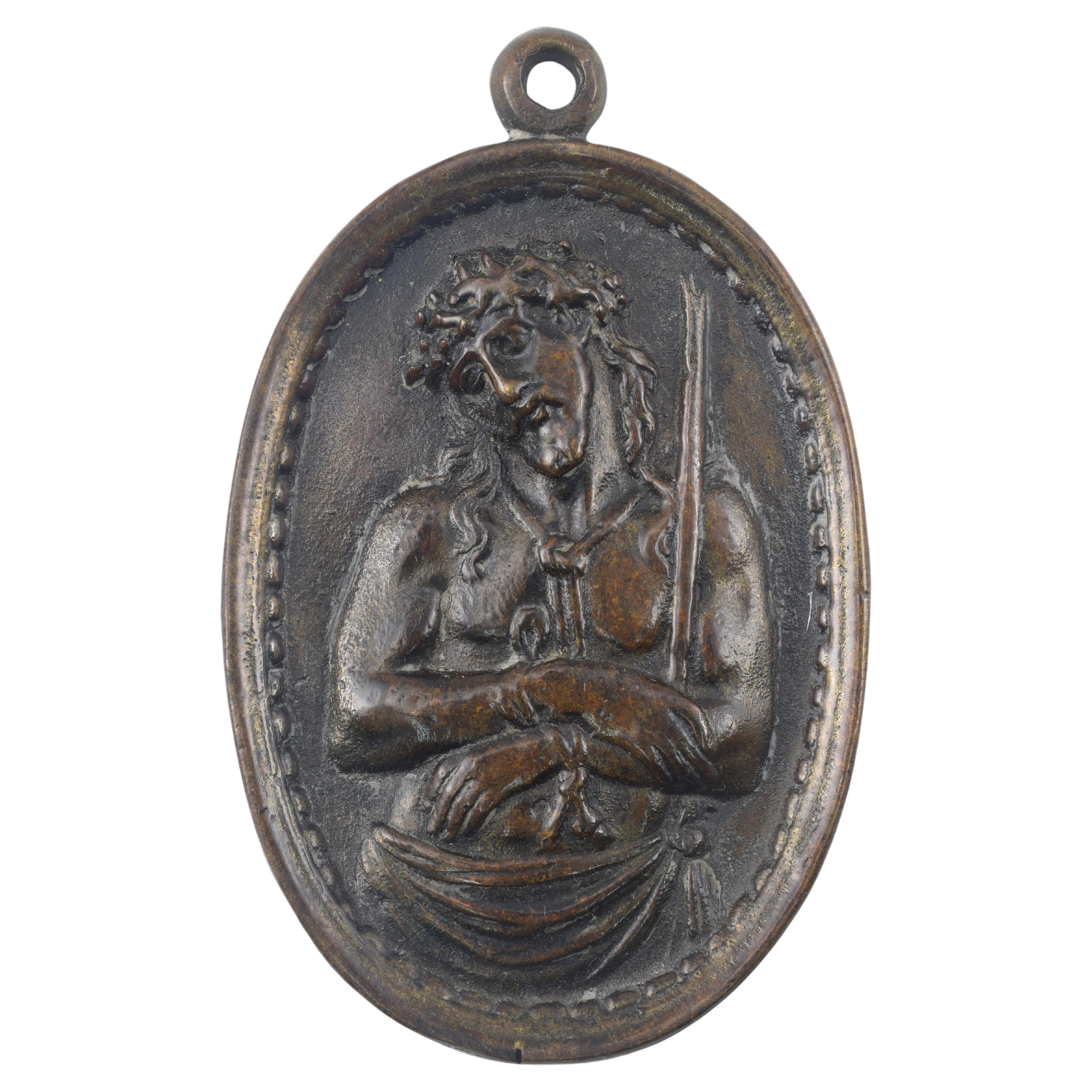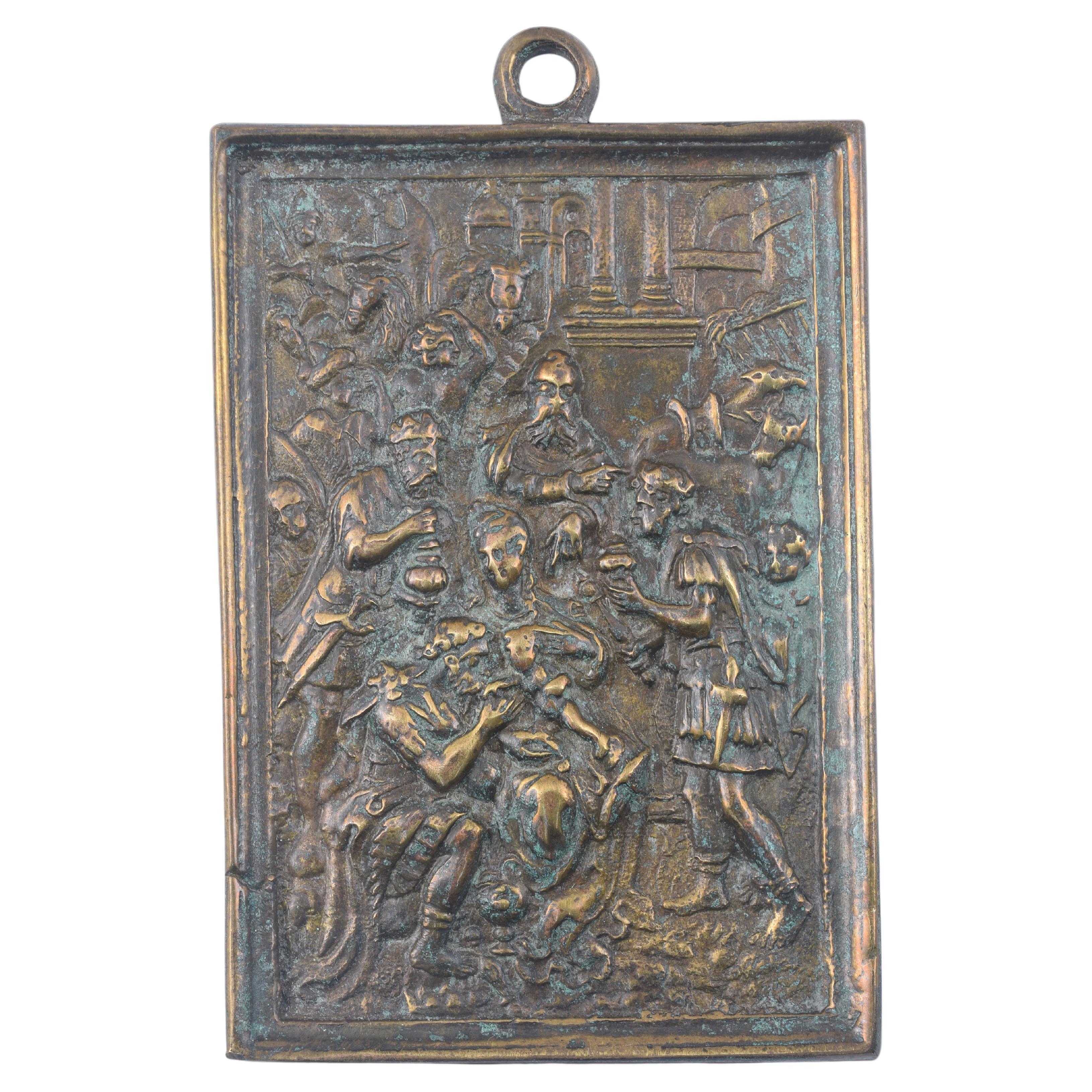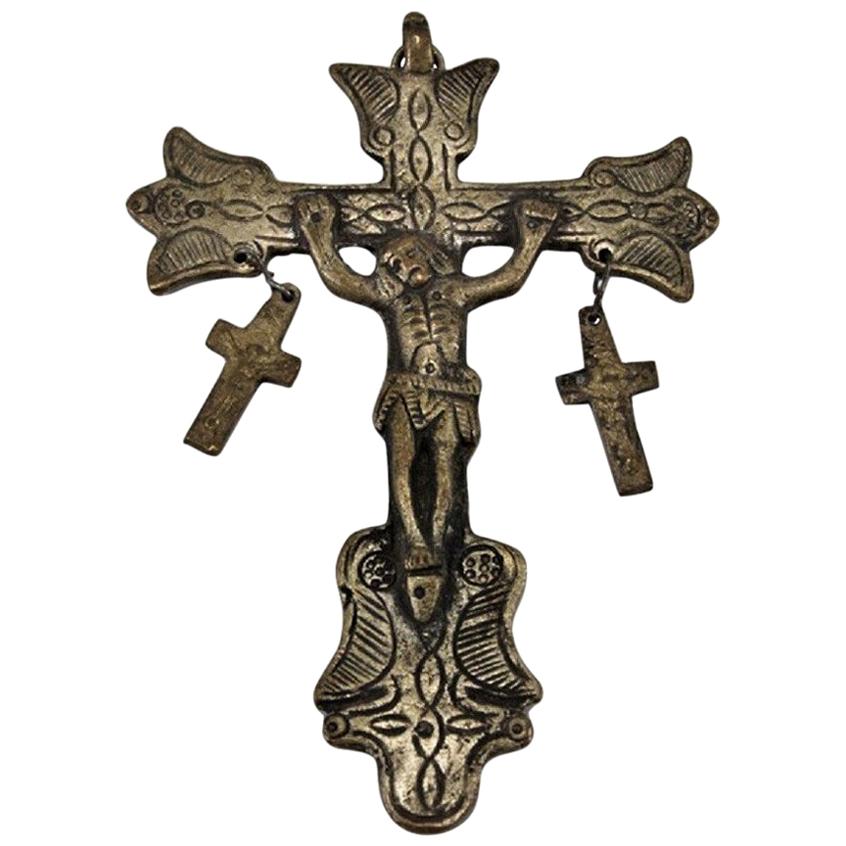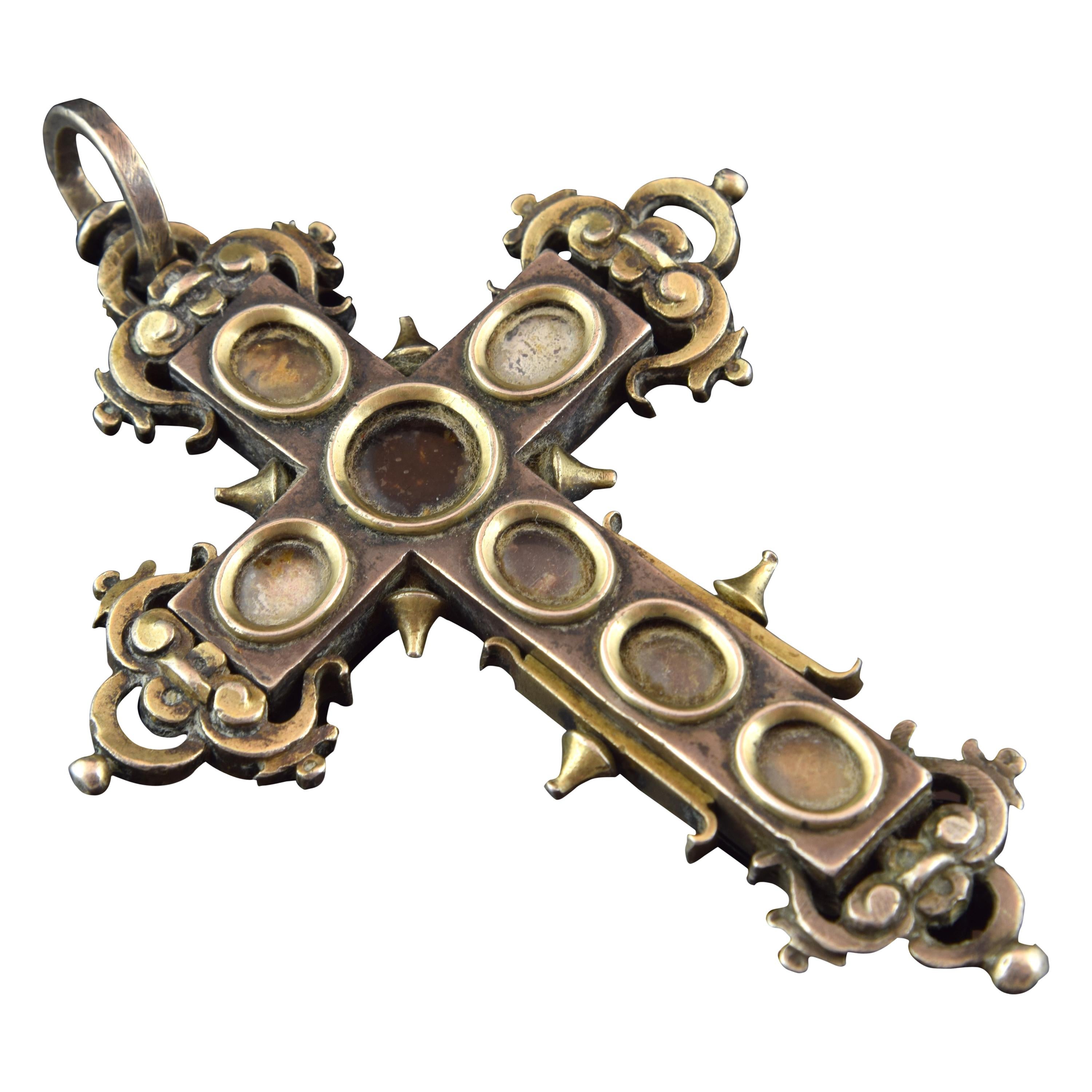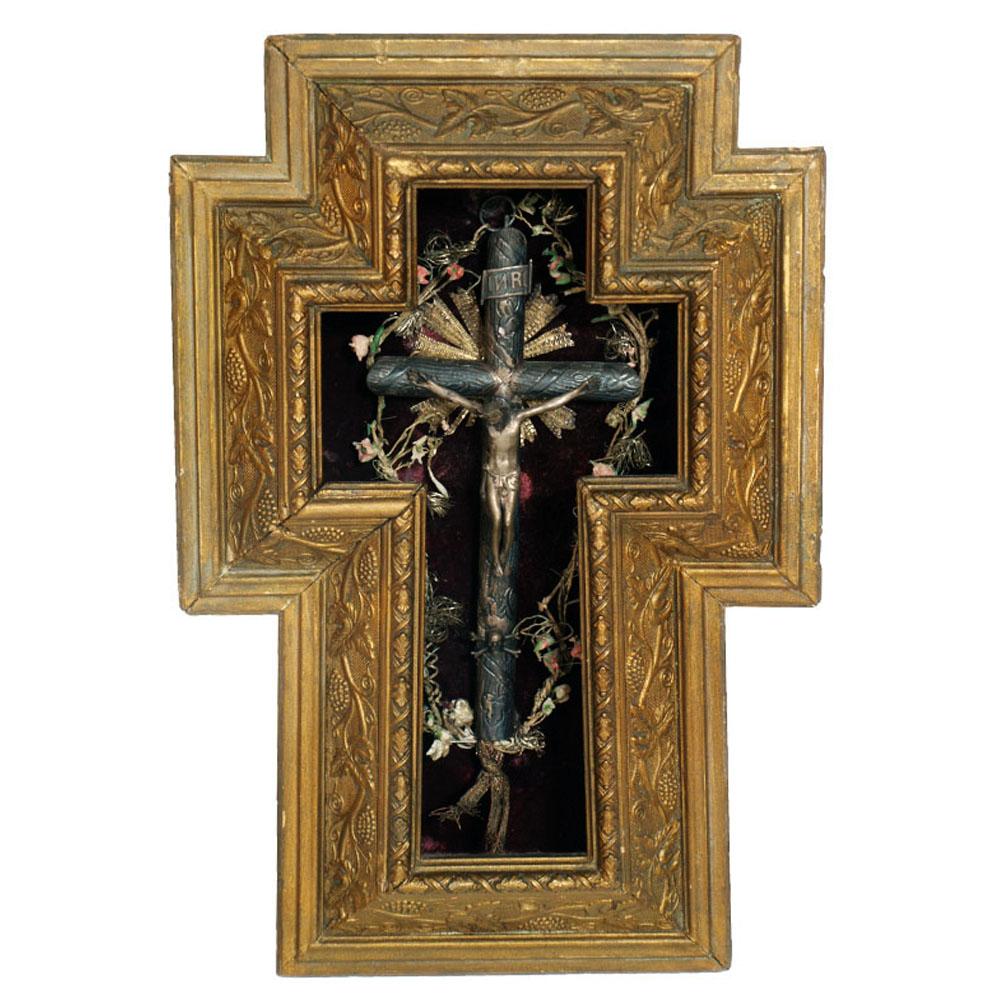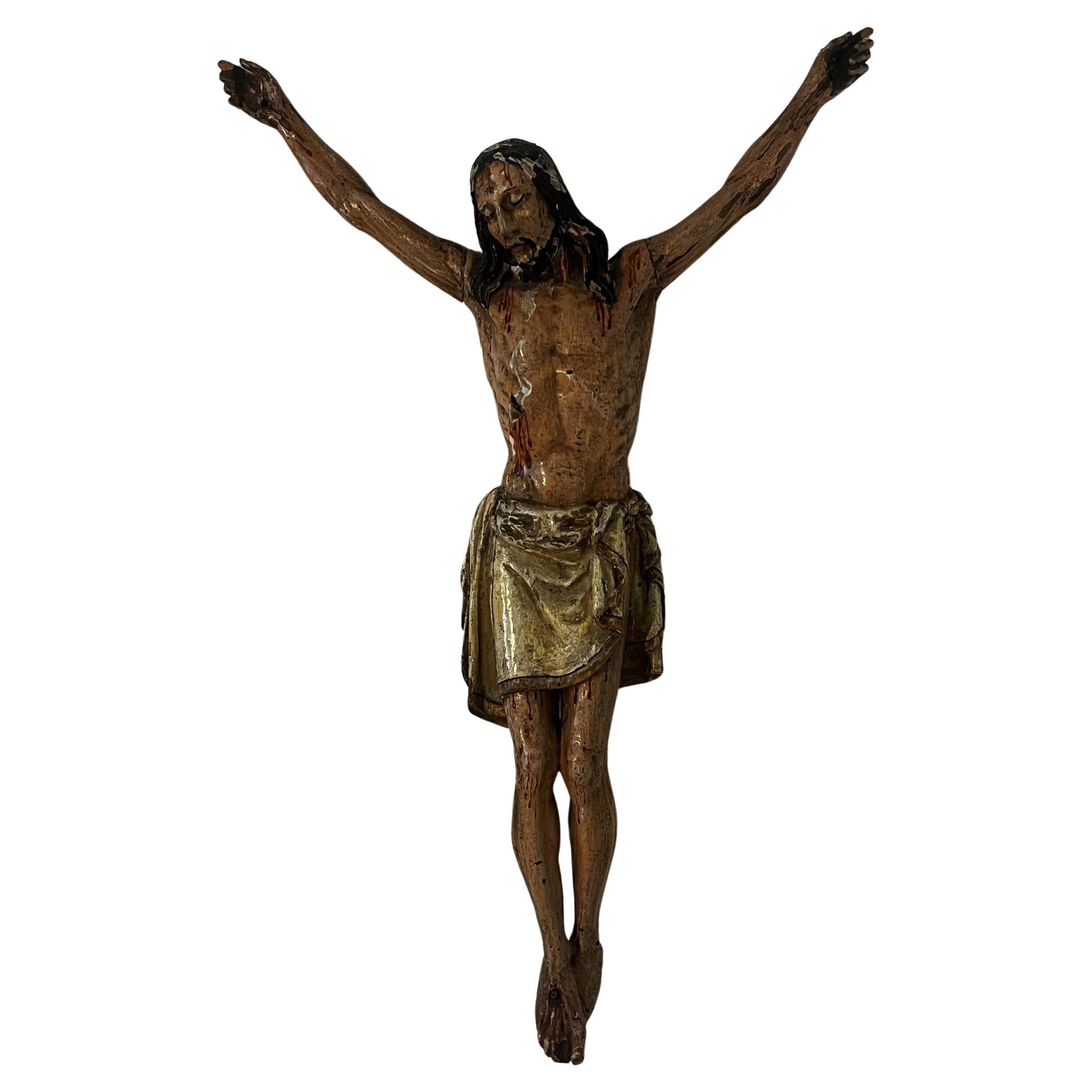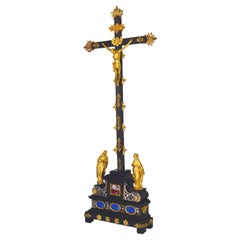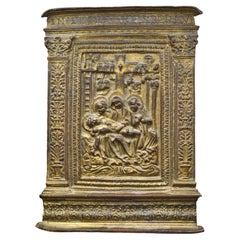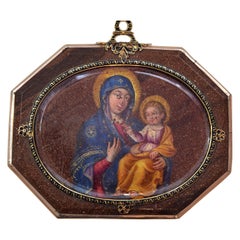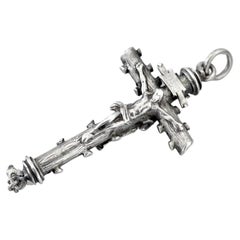
A mid-17th century silver crucifix devotional pendant
View Similar Items
Want more images or videos?
Request additional images or videos from the seller
1 of 8
A mid-17th century silver crucifix devotional pendant
About the Item
- Dimensions:Height: 4.34 in (11 cm)Width: 1.89 in (4.8 cm)Depth: 0.79 in (2 cm)
- Style:Baroque (Of the Period)
- Materials and Techniques:
- Place of Origin:
- Period:
- Date of Manufacture:17th century
- Condition:Wear consistent with age and use.
- Seller Location:Leesburg, VA
- Reference Number:1stDibs: LU8166234927032
About the Seller
5.0
Vetted Seller
These experienced sellers undergo a comprehensive evaluation by our team of in-house experts.
Established in 2013
1stDibs seller since 2023
20 sales on 1stDibs
Typical response time: 6 hours
More From This SellerView All
- A 17th century Roman Altar Cross after Guglielmo della PortaLocated in Leesburg, VAA 17th century Roman altar cross after Guglielmo della Porta Approximate size: 67 x 27 cm The present altar cross, likely of Italian Roman origin, reprod...Category
Antique 17th Century Italian Renaissance Religious Items
MaterialsAgate, Lapis Lazuli, Bronze
- Early 17th Century Netherlandish Oak Relief of the Three Divine VirtuesLocated in Leesburg, VAAn impressive early 17th century wood relief carving of the Three Divine Virtues After Jan Pietersz Saenredam and Hendrik Goltzius First quarter of the 17th century; Northern Netherlands Approximate size: 35.5 x 50 cm (without frame); 53 x 67 cm (with frame) The present carving, of Flemish origin and from the first quarter of the 17th century, was executed during the Golden Age of Dutch art. The relief depicts the figures of Pietas, Caritas and Fides: the divine virtues of Hope, Charity and Faith. Each of the Virtues is articulated with exceptional care and the skill of a talented hand. The composition is bursting with energy, emphasized by the active putti surrounding its central protagonist and the emergence of the figures in the foreground, silhouetted against a cityscape with the upper horizon framed by clouds and rays-of-glory. The relief’s design is indebted to late 16th century Mannerist influences shown in the expressive postures of the figures and the billowing hair of Charity. Other Flemish artists approached this theme like the painters, Maarten de Vos, Maarten van Heemskerck, et al. However, our particular carving is an amalgam of three individual compositions engraved by Jan Pietersz Saenredam in 1601, and based on the designs of his mentor and long-time collaborator, Hendrik Goltizius (presumably following inspired Latin prose conceived by the Haarlem Humanist, Cornelis Schonaeus). The relief is set in an elaborate checkered, wood-inlaid frame but its scale and shape suggest it probably once formed part of an elaborate Beeldenkast or impressive Dutch oak cupboard...Category
Antique 17th Century Dutch Baroque Decorative Art
MaterialsOak
$1,898 Sale Price49% Off - 15th century North Italian Gilt Bronze Pax of the LamentationLocated in Leesburg, VAAnonymous Second half of the 15th century; Northern Italy, possibly Milan Gilt bronze Approximate size: 17.2 x 13 cm The present pax probably derives from a finer original realized in more precious materials. For example, the vigor of its central motif is carved in such a way as to suggest the original artwork was conceived in carved stone or perhaps mother-of-pearl. The intricacy of its frame suggests a separate master adept in silverwork. Overall, this bronze pax...Category
Antique 15th Century and Earlier Italian Renaissance Religious Items
MaterialsBronze
- Beautifully aged pair of 17th cent. Baroque Italian Floral Still-Life PaintingsLocated in Leesburg, VAA beautifully aged pair of 17th century Baroque Italian Floral Still Life Paintings School or influence of Orsola Maddalena Caccia ...Category
Antique 17th Century Italian Baroque Paintings
MaterialsCanvas, Giltwood, Paint
- Pair of Late 17th Century Giltwood Spanish Altarpiece ElementsLocated in Leesburg, VAThe present pair of late 17th century or early 18th century Spanish Baroque giltwood architectural elements may have once formed part of an altarpiece environment. Their decorative p...Category
Antique Late 17th Century Wall-mounted Sculptures
MaterialsGiltwood
$1,496 Sale Price25% Off - 15th century Gilt Bronze Pax of the Virgin and Child, after DonatelloLocated in Leesburg, VAAnonymous, school of Donatello Second half of the 15th century; Northern Italy Approximate size: 13 x 7.6 cm The present relief of the Virgin and Child is largely considered derive...Category
Antique 15th Century and Earlier Italian Renaissance Religious Items
MaterialsBronze
You May Also Like
- Devotional Pendant, Saint James the Great, Bronze, Spain, 17th CenturyLocated in Madrid, ESDevotional medal, Santiago Apóstol. Ormolu, 17th century. Openwork devotional medal with the image of Santiago Apóstol in the center, on a pedestal and holding a staff and a book, surrounded by a crown of leaves knotted with two loops above and below. Copies similar to the present one are found in the Museum of Pilgrimages in Santiago de Compostela...Category
Antique 17th Century Spanish Baroque Religious Items
MaterialsBronze
- Devotional Pendant, Oil on Aventurine, Gold, Enamel, Spain, 17th CenturyLocated in Madrid, ESDevotional pendant or reliquary. Oil painting on aventurine, enamel, gold. Spain, 17th century. Medallion or devotional pendant or reliquary made of aventurine or aventurine with an octagonal shape and faceted fronts, enhanced with a series of enamels combining black and gold, which protect two oil paintings with a Catholic Christian religious theme, located one on each side of the piece. Protected, you can see a very particular Virgin with Child for being inspired by the Icon of the Madonna del Popolo (Rome, Italy), and a simplified Martyrdom of San Lorenzo (the saint, the grill and an angel with a crown and the palm corresponding to the subject). The edges of the piece have been protected with simple metal elements. The painting of San Lorenzo follows a common composition in the Spanish school, and would recall works such as the painting of the main altar of the Church of San Lorenzo de Huesca, for example, but also others such as the engraving by Marcantonio Raimondi (executed around 1527) in some details. The so-called icon of the Madonna del Popolo was well known for being considered as made by Saint Luke, and was brought to the church of the same denomination by Gregory IX from the Sancta Sanctorum of the Lateran Palace after a flood caused a terrible plague in the city and through a solemn procession with the image of Santa Maria del Popolo. Regarding the material of the piece, a certain type of glass and a type of quartz (which can be green or reddish-brown, and usually has tiny elements of yellow mica that give it golden reflections) is known as aventurine or aventurine. In the first case, it is known that “aventurine” or “stellaria” appears mentioned in the Murano workshops for the first time during the first quarter of the 17th century, in reference to a very complicated production paste (it is said that the name comes from of this circumstance, that is, that its creation was due to luck or luck) that imitates the effects of that stone (from India and Russia at that time) thanks to the inclusion of copper particles, and that it was used as if out of stone (cut) given the complexity of its use in blowing (practically impossible). And, dealing with this material, it is necessary to mention “The Nativity” by Pietro da Cortona, dated around 1656, which is kept in the El Prado...Category
Antique 17th Century Spanish Baroque Religious Items
MaterialsGold, Enamel, Other
- Reliquary Pendant, Silver, Enamel, 17th CenturyLocated in Madrid, ESOne of its fronts presents a textile background under a transparent glass, space that was surely designed to contain relics. The other side has a brightly colored enamel with the Vir...Category
Antique 17th Century European Baroque Religious Items
MaterialsSilver, Enamel, Other
- Devotional plaque, Immaculate Conception. Bronze. Spanish school, 17th century.Located in Madrid, ESDevotional plaque, Immaculate Conception. Bronze. Spanish school, 17th century. Bronze devotional plate with washer at the top that presents a relief on the front. In this you can s...Category
Antique 17th Century Spanish Baroque Religious Items
MaterialsBronze
- Devotional plaque, Ecce Homo. Bronze. Spanish school, 17th century.Located in Madrid, ESDevotional plaque, Ecce Homo. Bronze. Spanish school, 17th century. Bronze devotional plate with an oval shape and a washer at the top that presents a relief within a frame of smoot...Category
Antique 17th Century Spanish Baroque Religious Items
MaterialsBronze
- Devotional plaque, Adoration of the Magi. Bronze. Spanish school, 17th century.Located in Madrid, ESDevotional plaque, Adoration of the Three Wise Men. Bronze. Spanish school, 17th century. Rectangular devotional plaque made of bronze, which presents the scene of the Birth of Jesu...Category
Antique 17th Century Spanish Baroque Religious Items
MaterialsBronze
Recently Viewed
View AllMore Ways To Browse
Antique Crucifix Pendants
Rosary Crucifix
Virgin With Child 17th
Holy Water Wall
Escuela Espanola
Vintage Masonic Hat
Vintage Masonic Hats
Orthodox Incense
Orthodox Icon Mary Jesus
Porcelain Stoup
Brass Mezuzah
Gothic Churches
Vintage Religious Collectibles
Holy Water Fonts Antique
Italian Ex Voto
Antique Oak Religious Carving
Holy Relics
Jerusalem Coin
